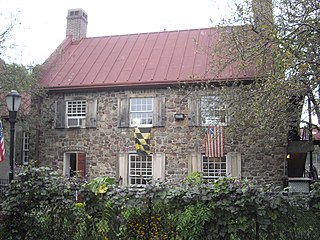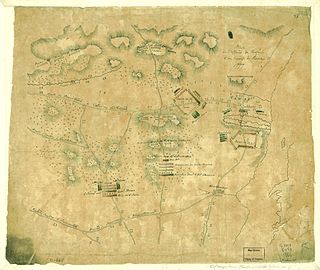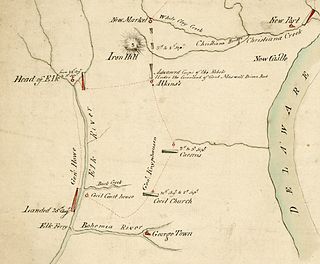
The Red Lion Inn was a tavern in Colonial New York located on Long Island in what is today the New York City borough of Brooklyn.

The Red Lion Inn was a tavern in Colonial New York located on Long Island in what is today the New York City borough of Brooklyn.
The inn, named in honor of Henry V of England for the tavern he rested in after the Battle of Agincourt, was at the junction of three country roads: the Narrows Road which led north from Denyse's Ferry; Martense Lane which passed through the Heights of Guan to Flatbush, and the Gowanus Road which led to Brooklyn Heights: this colonial era juncture is the modern day location of Fourth Avenue and 35th Street.
In the early morning hours of August 27, 1776, the first shots of the Battle of Brooklyn were fired here when British troops under Major General James Grant encountered American pickets stationed at the Red Lion. According to some accounts the British troops were foraging in a watermelon patch. After an initial exchange of musket fire, the Americans retreated in a panic up the Gowanus Road toward the Vechte house. Major Edward Burd who had been in command was captured along with a lieutenant and 15 privates.
Samuel Holden Parsons a lawyer from Connecticut who had secured a commission in the Continental Army and was recently promoted to Brigadier General was Field Officer of the Day. He and Colonel Samuel John Atlee of Pennsylvania, a veteran of the French and Indian War were stationed further north on the Gowanus Road. The two colonels roused from their sleep by the sound of musket fire managed to intercept some of the troops fleeing from the British at the Red Lion and form them into a skirmish line. They also sent word to Major General Israel Putnam at Brooklyn that the enemy was advancing. At three o'clock General Putnam informed Brigadier General (William Alexander) Lord Stirling and directed him to meet the enemy. Stirling set out with the available companies of the Maryland and Delaware regiments. Stirling's force, totaling about 1,500 men, encountered the British within a half mile of the Red Lion and formed for battle. At daybreak Stirling and Parsons would be reinforced with 400 troops sent by General John Sullivan from those near the Flatbush Pass. The reinforcements brought the total American strength up to 2,100 troops under Lord Stirling's command. The British troops under General Grant, also being reinforced, would reach over 7,000 troops. Stirling's force stood firm under British cannon and musket fire for about four hours. At that point Grant advanced his forces and Stirling gradually fell back along the Gowanus Road toward Brooklyn. Other British forces under General Charles Earl Cornwallis and Hessians under General Leopold Philip de Heister were already in Stirling's rear and his force began to come apart as they encountered other American units fleeing west over the fields and along the Port Road to cross the Gowanus marshes to the safety of the main American defensive line at Brooklyn.
In the fighting near the Old Stone House and Brouwer's Mills, one battalion of 400 troops from Colonel William Smallwood's 1st Maryland Regiment led by Major Mordecai Gist and still under Lord Stirling's command, would engage these 2,000 British and Hessian troops to cover the thousands of Americans retreating across the marshes and Gowanus creek. During other nearby fighting, Colonel Atlee was captured by the British and General Parsons was eventually able to escape to the American lines. [1] [2] [3]

The Battle of Long Island, also known as the Battle of Brooklyn and the Battle of Brooklyn Heights, was an action of the American Revolutionary War fought on August 27, 1776, at and near the western edge of Long Island in present-day Brooklyn. The British defeated the Continental Army and gained access to the strategically important Port of New York, which they held for the rest of the war. It was the first major battle to take place after the United States declared its independence on July 4, 1776, in Philadelphia. It was the largest battle of the Revolutionary War in terms of both troop deployment and combat.

The Battle of Trenton was a small but pivotal American Revolutionary War battle on the morning of December 26, 1776, in Trenton, New Jersey. After General George Washington's crossing of the Delaware River north of Trenton the previous night, Washington led the main body of the Continental Army against Hessian auxiliaries garrisoned at Trenton. After a brief battle, almost two-thirds of the Hessian force were captured, with negligible losses to the Americans. The battle significantly boosted the Continental Army's waning morale, and inspired re-enlistments.

The Battle of White Plains took place during the New York and New Jersey campaign of the American Revolutionary War on October 28, 1776, near White Plains, New York. Following the retreat of George Washington's Continental Army northward from New York City, British General William Howe landed troops in Westchester County, intending to cut off Washington's escape route. Alerted to this move, Washington retreated farther, establishing a position in the village of White Plains but failing to establish firm control over local high ground. Howe's troops drove Washington's troops from a hill near the village; following this loss, Washington ordered the Americans to retreat farther north.

The Old Stone House is a house located in the Park Slope neighborhood of Brooklyn, New York City. The Old Stone House is situated within the J. J. Byrne Playground, at Washington Park, on Third Street between Fourth and Fifth Avenues. Gowanus Creek once ran nearby, but today the southeastern branch of the Gowanus Canal ends 1,300 feet (400 m) west of the house.

Count Carl Emil Ulrich von Donop was a Hessian colonel who fought in the American Revolutionary War. He died of wounds during the Battle of Red Bank.
Samuel John Atlee was an American soldier and statesman from Lancaster, Pennsylvania. He was a delegate to the Continental Congress for the Province of Pennsylvania from 1778 to 1782.

George Washington's crossing of the Delaware River, which occurred on the night of December 25–26, 1776, during the American Revolutionary War, was the first move in a complex and surprise military maneuver organized by George Washington, the commander-in-chief of the Continental Army, which culminated in their attack on Hessian forces garrisoned at Trenton. The Hessians were German mercenaries hired by the British.
John Haslet was an American Presbyterian clergyman and soldier from Milford, in Kent County, Delaware. He was a veteran of the French and Indian War and an officer of the Continental Army in the American Revolution, serving as the first Colonel of the 1st Delaware Regiment. He was killed in action at the Battle of Princeton.

The Battle of the Assunpink Creek, also known as the Second Battle of Trenton, was a battle between American and British troops that took place in and around Trenton, New Jersey, on January 2, 1777, during the American Revolutionary War, and resulted in an American victory.
The 8th Virginia Regiment or German Regiment was an infantry unit that served in the Continental Army during the American Revolutionary War. Authorized in January 1776, the regiment was raised from men of several northwestern counties in the strength of 10 companies. Its first commander was Colonel Peter Muhlenberg, a clergyman and militia leader. The unit marched to defend Charleston, South Carolina in 1776, but saw no fighting. At the start of 1777, the 8th Virginia moved to join George Washington's main army. When Muhlenberg was promoted to general officer, Colonel Abraham Bowman took command of the unit.

The Battle of Fort Washington was fought in New York on November 16, 1776, during the American Revolutionary War between the United States and Great Britain. It was a British victory that gained the surrender of the remnant of the garrison of Fort Washington near the north end of Manhattan. It was one of the worst Patriot defeats of the war.
The Battle of Connecticut Farms, fought June 7, 1780, was one of the last major battles between British and American forces in the northern colonies during the American Revolutionary War. Hessian General Wilhelm von Knyphausen, in command of the British garrison at New York City, made an attempt to reach the principal Continental Army encampment at Morristown, New Jersey. Knyphausen's advance was strongly met by companies of the New Jersey militia at Connecticut Farms. After stiff resistance, the militia were forced to withdraw, but the battle and skirmishing that preceded it sufficiently delayed Knyphausen's advance that he remained there for the night. After realizing that further advance on Morristown would probably be met by even more resistance, Knyphausen withdrew back toward New York.

The Battle of the Short Hills was a conflict between a Continental Army force commanded by Brigadier General William Alexander, and an opposing British force commanded by Lieutenant General William Howe. The battle took place on June 26, 1777, at Scotch Plains and Edison, New Jersey, during the American Revolutionary War.

The Battle of Iron Works Hill, also known as the Battle of Mount Holly, was a series of minor skirmishes that took place on December 22 and 23, 1776, during the American Revolutionary War. The fighting took place in Mount Holly, New Jersey, between an American force mostly composed of colonial militia under Colonel Samuel Griffin and a force of 2,000 Hessians and British regulars under Carl von Donop.

The Battle of Cooch's Bridge, also known as the Battle of Iron Hill, was fought on September 3, 1777, between the Continental Army and American militia and primarily German soldiers serving alongside the British Army during the American Revolutionary War. It was the only significant military action during the war on the soil of Delaware, and it took place about a week before the major Battle of Brandywine. Some traditions claim this as the first battle which saw the U.S. flag.

The Battle of Trenton was fought on December 26, 1776, during the American Revolutionary War campaign for New Jersey. In a surprise attack, the Continental Army led by George Washington attacked the winter quarters of a brigade composed primarily of German troops from Hesse-Kassel in Trenton, New Jersey. The Hessian brigade was under the command of Colonel Johann Rall; he died of wounds sustained in the battle, and about two thirds of his men were taken prisoner. It was the first major victory after a long string of defeats that had resulted in the loss of New York City, and was a significant boost to American morale. It was followed by two more American victories, first in a second battle at Trenton on January 2, 1777, and then on January 3 at Princeton.

The Heights of Guan is a historical name given to a series of hills extending in a ridge along western Long Island in New York State. The ridge extends in an east-northeast direction across the modern-day New York City boroughs of Brooklyn and Queens, with hills varying in height from 100 to 150 feet. The southern slope of the ridge has a relatively steep drop and the northern slope is more gradual. Further to the south is an outwash plain bordered by the Atlantic Ocean. Geologically, the ridge is part of the Harbor Hill Moraine formed 13,000 to 12,000 years ago during the Wisconsin glaciation.

The Maryland 400 were members of the 1st Maryland Regiment who repeatedly charged a numerically superior British force during the Battle of Long Island during the Revolutionary War, sustaining heavy casualties, but allowing General Washington to successfully evacuate the bulk of his troops to Manhattan. This action is commemorated in Maryland's nickname, the "Old Line State." A monument in Brooklyn and multiple plaques were put up in the memory of this regiment and the fallen soldiers.

Battle Pass, formerly known as Flatbush Pass or Valley Grove or The Porte, is a historic hill pass that played a significant part in the 1776 Battle of Long Island, and that is currently part of Prospect Park in Brooklyn.
Red Hook Lane Arresick is a revolutionary war burial ground in Red Hook, Brooklyn. During the Battle of Brooklyn, General Stirling's retreating forces fought a rearguard action. Continental Army riflemen fleeing the destruction of Fort Defiance fired shots at British troops advancing on the Carnarsie Indian path through Gowanus, killing a Lt. Colonel and his aide. They and the Pennsylvanian rifleman who shot them are buried together nearby on the path later called Red Hook Lane.